| 1 |
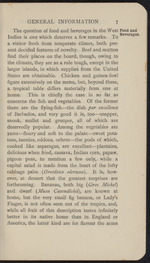 |
“...rule tough, except in the
larger islands, in which supplies from the United
States are obtainable. Chicken and guinea-fowl
figure extensively on the menu, but, beyond these,
a tropical table differs materially from one at
home. This is chiefly the case in so far as
concerns the fish and vegetables. Of the former
there are the flying-fish—the dish par excellence
of Barbados, and very good it is, too—snapper,
snook, mullet and grouper, all of which are
deservedly popular. Among the vegetables are
yams—floury and soft to the palate—sweet pota-
toes, tannias, eddoes, ochros—the pods of which,
cooked like asparagus, are excellent—plantains,
delicious when fried, cassava, Indian corn, papaw,
pigeon peas, to mention a few only, while a
capital salad is made from the heart of the lofty
cabbage palm (Oreodoxa oleracea). It is, how-
ever, at dessert that the greatest surprises are
forthcoming. Bananas, both big (Gros Michel)
and dwarf (Musa Cavendishii), are known at
home, but the very small fig banana...”
|
|
| 2 |
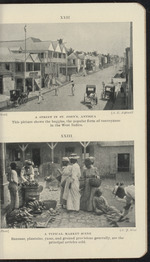 |
“...XXII
ppm:.
\A. E. A spinaic
A STREET IN ST. JOHN’S, ANTIGUA
This picture shows the buggies, the popular form of conveyance
in the West Indies.
XXIII
t"r I. V
i%ö/o] [^. y. fVest
A TYPICAL MARKET SCENE
Bananas, plantains, yams, and ground provisions generally, are the
principal articles sold....”
|
|
| 3 |
 |
“...Industries.
Climate.
History.
Constitu-
tion.
226 GUIDE TO THE WEST INDIES
St. Kitts the island is volcanic, and the general
characteristics of both the islands closely resemble
one another. Nevis is practically one large moun-
tain cone rising to a height of 3596 feet.
As in St. Kitts, sugar is the principal industry
in Nevis, but of late years the exports of this
commodity have been steadily declining in value.
The cultivation of Sea Island cotton is, on the
other hand, being rapidly extended. Yams, sweet
potatoes, corn, &c., are also cultivated to a con-
siderable extent.
The climate of Nevis is very similar to that of
St. Kitts, though the rainfall is less, being only
45 and 80 inches. There are practically no
streams in the island, and the water supply is
derived from a public reservoir, which supplies
Charlestown and some country districts with good
water.
Nevis was discovered by Columbus in 1493i on I
his second voyage, and was so called by him owing
to the cloud-capped summit of its...”
|
|
| 4 |
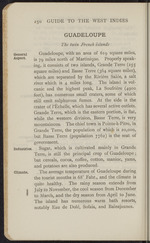 |
“...still emit sulphurous fumes. At the side is the
crater of 1’Êchelle, which has several active outlets.
Grande Terre, which is the eastern portion, is flat,
while the western division, Basse Terre, is very
mountainous. The chief town is Pointe-k-Pitre, in
Grande Terre, the population of which is 20,000,
but Basse Terre (population 7762) is the seat of
government.
Sugar, which is cultivated mainly in Grande
Terre, is still the principal crop of Guadeloupe;
but cereals, cocoa, coffee, cotton, manioc, yams,
and potatoes are also produced.
The average temperature of Guadeloupe during
the tourist months is 68° Fahr., and the climate is
quite healthy. The rainy season extends from
July to November, the cool season from December
to March, and the dry season from April to June.
The island has numerous warm bath resorts,
notably Eau de Dolé, Sofaia, and Bainsjaunes....”
|
|
| 5 |
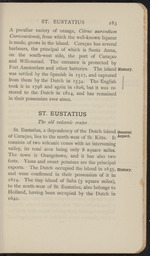 |
“...1527, and captured .
from them by the Dutch in 1534. The English
took it in 1798 and again in 1806, but it was re- I
stored to the Dutch in 1814, and has remained
in their possession ever since.
ST. EUSTATIUS
The old volcanic crater
St. Eustatius, a dependency of the Dutch island General
of Curagao, lies to the north-west of St. Kitts. It ^P®®1-
consists of two volcanic cones with an intervening
valley, its total area being only 8 square miles.
The town is Orangetown, and it has also two
forts. Yams and sweet potatoes are the principal
exports. The Dutch occupied the island in 1635, History,
and were confirmed in their possession of it in
1814. The tiny island of Saba (5 square miles),
to the north-west of St. Eustatius, also belongs to
Holland, having been occupied by the Dutch in
1640....”
|
|
| 6 |
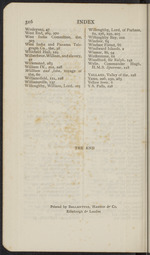 |
“...303
West India and Panama Tele-
graph Co., the, 38
Whitfield Hall, 129
Wilberforce.William, and slavery,
42
Willemstad, 283
William IV., 212, 228
William and John, voyage of
the, 60
Williamsfield, hi, 128
Williamsville, 137
Willoughby, William, Lord, 205
Willoughby, Lord, of Parham,
62, 176, 192, 205
Willoughby Bay, 202
Windsor, 65
Windsor Forest, 86
Windward Islands, 2
Wismar, 86, 94
Wolferstone, 61
Woodford, Sir Ralph, 141
Wylie, Commander Hugh,
H.M.S. Sparrow, 118
Yallahs, Valley of the, 128
Yams, 226, 250, 283
Yellow fever, 6
Y.S. Falls, 128
THE END
Printed by Ballantynb, Hanson 6t* Co.
Edinburgh London...”
|
|
